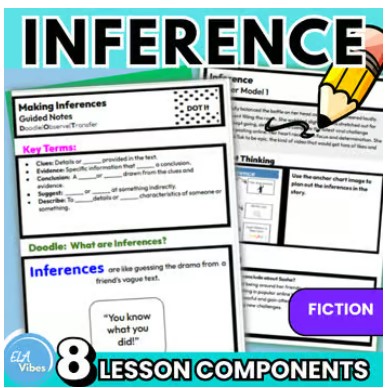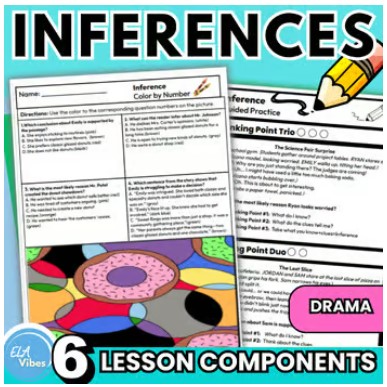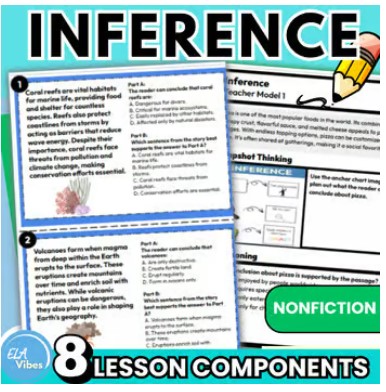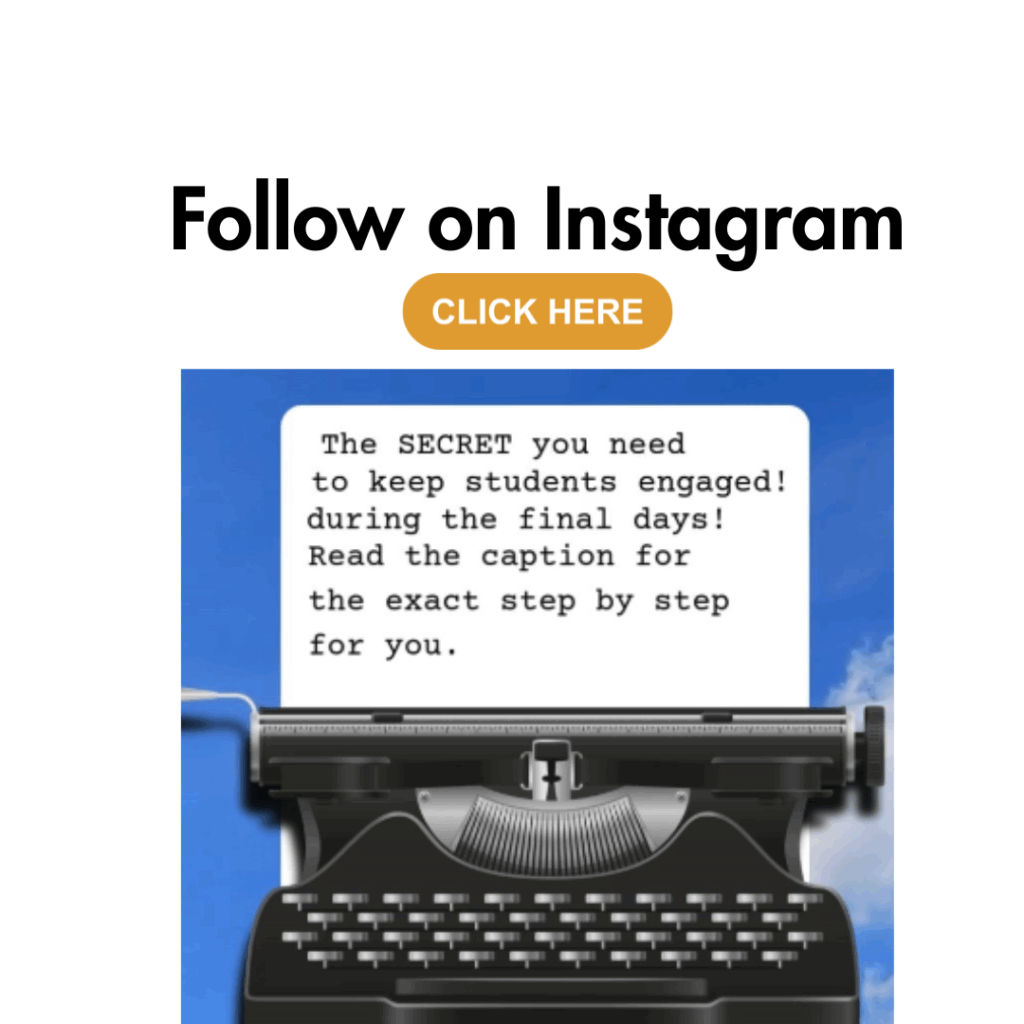Last updated on June 18th, 2025 at 07:43 pm
Helping students make inferences is one of the most important steps in building strong reading comprehension. It helps kids move from just reading words to actually understanding what’s going on beneath the surface. Whether you’re using wordless picture books, short stories, or nonfiction passages, inferential thinking lets readers figure out what’s not directly said. In this post, I’ll talk about what inferences are, why they matter, how to teach them in a way that sticks, and how to know if your students are actually getting it. I’ll also clear up a few common misunderstandings and share some simple examples.
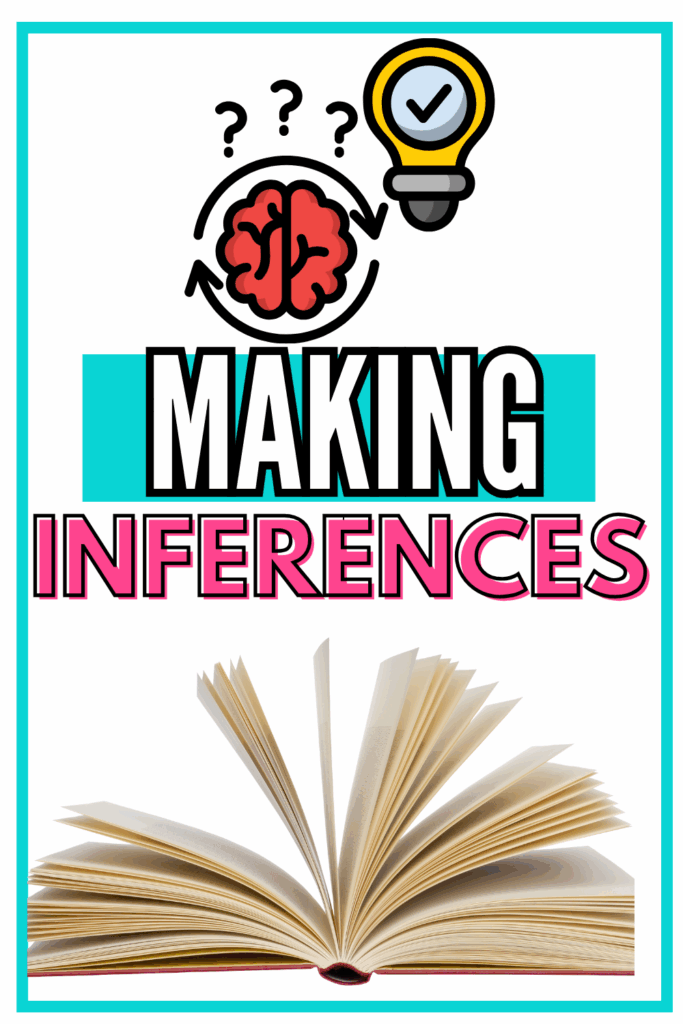
What Does Making Inferences Mean?
Making inferences is just a fancy way of saying you’re putting two and two together. It means using clues from the story (text evidence) and what you already know (background knowledge) to figure something out that the author didn’t say outright. Take What You Know + The Clues=Inference.
For example, if a story says, “The girl slammed her locker and stormed down the hall,” most students can infer that she’s mad. The story doesn’t say it, but her actions give it away. That’s an inference. And it’s where personal experience really helps, because we all know what it looks like when someone’s frustrated.
Why Are Inferences Important?
Inference skills are a huge part of reading comprehension. Without them, students miss a lot of what authors are trying to say.
- Missing inferences is like watching a movie on mute.
You’ll miss the emotions and meaning behind the scenes. - Inferential thinking applies beyond reading.
- In math: we infer patterns.
- In science: we draw conclusions from experiments.
- In life: we interpret what people mean, even when they don’t say it outright.
- Practicing inferencing builds important life skills:
- Analytical thinking
- Empathy
- Independence
- Students need repeated, varied practice.
Since reading skills grow over time, they need many chances to infer meaning in different ways.

Are Making Inferences and Drawing Conclusions the Same?
They’re similar, but not exactly the same.
Making an inference is what happens in the moment. You’re picking up on little clues as you read. Drawing a conclusion is what happens after you’ve collected a few inferences and you’re ready to sum it all up.
For example:
- Inference: She covered her face with her hands and sniffled.
- Conclusion: She’s upset and probably crying because something bad happened.
The conclusion pulls together smaller inferences. Both depend on using text evidence and background knowledge.
What Are Common Misconceptions with Inferring?
- Inferring without support: Some students think inferring means guessing wildly. If there’s no clue in the text to back it up, it’s not an inference.
- Overusing personal experience: Students might rely too much on what they’ve lived through and ignore the actual story. We want them to use their own experiences, but also pay close attention to what the author gives them.
- Sticking only to the text: On the flip side, some kids won’t infer at all. They read only what’s written and miss the deeper layers. This can be especially true if they struggle with vocabulary or understanding inference of word meanings.
- Missing cultural context: Not all students come with the same background knowledge. These individual differences can make some inferences harder. That’s why it helps to include diverse books and build background before diving into deep reading.
How do I teach making inferences in upper elementary?
- Start with pictures: Wordless picture books and short videos are great because kids don’t have to read words to understand the meaning. It’s all about observing and thinking.
- Model your thinking: Read a short passage out loud and talk through your thoughts. “He won’t look at her and his face is red. I think he’s embarrassed.” You’re showing how to mix text evidence with background knowledge.
- Use simple sentence frames:
- I think _ because the text says _and I know _.
- Based on _, I can infer _.
- Try quick warm-ups: Riddles or simple statements are a perfect way to kick things off. “Her umbrella flipped inside out, and her hair was soaked.” Most students will infer that it’s windy and rainy.
- Make time for conversation: Let students talk through their thinking. Partners or small groups are perfect for hearing different perspectives.
- Link it to writing: Ask students to write without stating feelings outright. Then let others read and guess how the character feels. This back-and-forth builds great inferential thinking.
Download these no-prep Making Inference Mini Lessons. Click on the images for more details. ⬇️⬇️
inference lesson plan
📘Learning Objective: Students will make inferences using text evidence and their own background knowledge, and explain their thinking using a structured sentence stem and graphic organizer.
🧰 Materials:
- Short, grade-appropriate fiction passage (or an excerpt from Because of Winn-Dixie or Each Kindness)
- Inference Organizer
- Anchor chart: What Is an Inference?
🕓 Lesson Procedures
🔍 1. Hook & Engagement (5–7 minutes)
- Display an image (e.g., a cartoon of a child with a backpack in the rain).
- Ask:
- What do you see?
- What do you think is happening?
- Guide them toward the idea of using clues + what they know.
- Introduce the anchor chart:
- Clues from the Text
- What I Know
- My Inference
📖 2. Direct Teaching (10 minutes)
- Write a sentence on the board:
Jenny stared at the floor. Her eyes were red. She didn’t say a word during recess. - Think-aloud: “The author didn’t say Jenny is sad. But I notice red eyes and silence, and I know that sometimes people act like that when they’re upset. So I infer Jenny might be sad.”
- Use the organizer to model:
- It Says: “Jenny stared at the floor.”
- I Say: “When people do that, they’re often upset.”
- So: “Jenny might be feeling sad or left out.”
🤝 3. Guided Practice (15 minutes)
- Read a short excerpt aloud.
- Pause after 2–3 lines and ask: “What clues are in the text?”
“What do you already know?”
“What can we infer?” - Students complete the inference organizer with you or a partner.
- Use sentence frames: “I think _ because the text says _and I know _.”
✍️ 4. Independent Practice (10 minutes)
- Provide a new short passage or reread from a familiar class text.
- Ask students to:
- Find 1 inference
- Highlight the clue
- Explain their thinking in writing using the sentence frame
🔁 5. Exit Ticket & Assessment (3 minutes)
- Give each student a sticky note: “Write one inference you made and the clue that helped you.”
- Collect to check for understanding.
Examples of making inferences
Here are a few go-to sentences to help students practice:
The sky turned dark, and the wind picked up speed.
Inference: A storm’s coming.
Jason’s hands were trembling as he approached the stage.
Inference: He’s probably nervous.
The front lawn was scattered with broken eggs and toilet paper.
Inference: Someone pulled a prank.
Maria’s backpack was open and her homework was missing.
Inference: She may have lost it.
Each example helps students use text evidence, background knowledge, and own experiences. And the more they practice, the better they get.

How Do I Assess Inference Skills Effectively?
Assessing inference skills doesn’t always mean giving multiple-choice tests. Try a mix of methods:
- Exit tickets: Have students write a quick response to a short passage. Ask them to support their answer with text evidence.
- Graphic organizers: Use charts where students write what the text says, what they already know, and what they infer. It’s a great way to see how they’re thinking.
- Listen in during group work: As students answer inferential questions, listen for whether they’re connecting ideas and giving support.
- Use rubrics: Score how well students make an inference, explain it, and support it with evidence. Keep it simple.
- Incorporate writing: Ask open-ended questions like: “Why do you think the character acted that way?” Look for a blend of personal experience, text evidence, and logic.
- Try mini quizzes: Use short reading passages and ask for written responses to inferential questions. These are great checkpoints.
The goal is to see how students are thinking, not just whether they got it right. Assessments should show their process and how well they connect ideas.
How to Differentiate Using Inferences
Not all students will approach inference the same way. That’s ok because students grow at different rates. Here are a few ways to differentiate:
- For emerging readers: Use wordless picture books, visuals, and video clips to focus on body language and setting. Let them draw their inferences or explain them aloud instead of writing.
- For ELLs: Pre-teach key vocabulary and use sentence frames like “I can tell _ because _.” Give them visuals or bilingual glossaries so they can match actions or facial expressions with emotions.
- For on-level readers: Mix fiction and nonfiction texts. Offer a choice of inference questions and encourage students to support their answers with more than one piece of text evidence.
- For advanced students: Ask them to compare multiple characters’ motives or predict future events based on subtle clues. Let them analyze irony or tone using inference skills.
- Leverage group discussion: Pair students with mixed abilities. Stronger students model how they think out loud, while others gain confidence hearing different angles.
- For Kinesthetic Leaners: Use escape rooms to add movement
Grab this ready-to-use differentiated toolbox for making inferences to meet the needs of all your students. Click here.
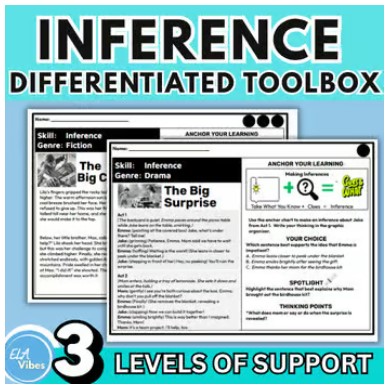
Conclusion: Making INferences
Teaching kids to make inferences helps them become thoughtful, independent readers. It teaches them to slow down, ask questions, and look beneath the surface. And while it can take time, the payoff is worth it. Start small, use pictures, model your own thinking, and let students talk it out. Most importantly, give them room to grow. With practice and good support, your students will start reading at a much deeper level than you might expect.
And don’t forget, inference is more than just a reading skill. It’s a thinking skill for life.
Additional Resources to Add to Your Toolbox

Favorite Amazon Items to Support Making Inferences
This post contains affiliate links, which means I may earn a small commission at no extra cost to you. I only share resources I truly love and use myself—thanks for supporting my corner of the teacher world!
